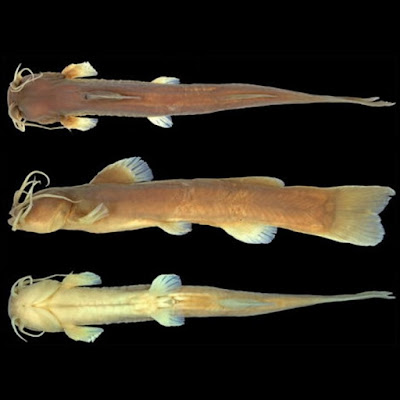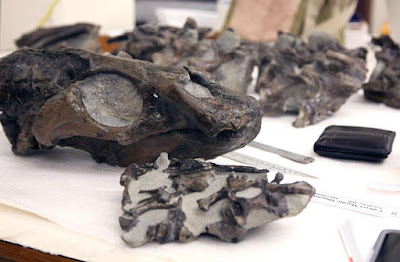[Most Recent Entries] [Calendar View]
Monday, January 8th, 2018
| Time | Event | ||||
| 8:21a | [Ichthyology • 2018] Amblyceps improcerum • A New Sisoroid Catfish (Siluriformes: Amblycipitidae) from Kachin State, Myanmar
Abstract A new species of amblycipitid catfish is here described from the Indawgyi Lake basin of the Irrawaddy River drainage in Kachin State, Myanmar as Amblyceps improcerum, new species. It can be distinguished from congeners in having a unique combination of the following characters: lower jaw longer than upper; head length 17.4–22.3% SL; head width 13.7–15.2% SL; head depth 9.0–11.7% SL; interorbital distance 31–39% HL; eye diameter 7–10% HL; 37–38 vertebrae; lateral line incomplete; predorsal length 25.5–30.7% SL; smooth posterior margin of pectoral spine; pectoral-fin length 13.5–16.8% SL; pelvic-fin length 9.6–13.4% SL; dorsal-to-adipose distance 25.2–28.7% SL; length of adipose-fin base 19.4–23.3% SL; adipose fin separate from dorsal procurrent caudal-fin rays; preanal length 62.1–66.9% SL; body depth at anus 9.8–12.8% SL; depth of caudal peduncle 10.1–12.6% SL; length of caudal peduncle 21.4–24.0% SL, post-adipose distance 15.8–17.8% SL; weakly-forked caudal fin with short broadly, rounded lobes (length of longest ray 1.3–1.5 times length of median rays); centrally projecting hooks on proximal lepidotrichia of median caudal-fin rays absent. Keywords: Ostariophysi, Sisoroidea, Irrawaddy river, New species
Amblyceps improcerum, new species Etymology: The specific epithet comes from the Latin adjective improcerus, −a, −um, meaning "not tall" or "undersized", in reference to the relatively short caudalfin lobes and adipose-fin base of this species when compared to nearly all congeners. Heok Hee Ng and Maurice Kottelat. 2018. Amblyceps improcerum, A New Sisoroid Catfish from Kachin State, Myanmar (Teleostei: Siluriformes: Amblycipitidae). Environmental Biology of Fishes. DOI: 10.1007/s10641-017-0712-0 | ||||
| 9:40a | [PaleoMammalogy • 2018] Allodesmus demerei • The Last of the Desmatophocid Seals: A New Species of Allodesmus from the upper Miocene of Washington, USA, and A Revision of the Taxonomy of Desmatophocidae
Abstract The family Desmatophocidae represents an early radiation of extinct pinnipeds that peaked in diversity during the middle Miocene. Although represented by abundant well-preserved fossils, the taxonomy and evolutionary relationships of this family remain poorly known. Late Miocene desmatophocids have been recorded, although none have been formally described, preventing a thorough appraisal of their decline and extinction. We report the discovery of a new species, Allodesmus demerei sp. nov., represented by a partial skeleton with cranium, mandibles, and axial skeleton, from the upper Miocene Montesano Formation of Washington, prompting reinterpretation of desmatophocid taxonomy, phylogeny, and extinction. Phylogenetic analysis (95 characters, 26 taxa) found strong support for monophyletic Desmatophocidae and Allodesmus. Desmatophocidae was found as sister to Phocidae with poor support. Allodesmus demerei was placed within the Allodesmus as the sister taxon to Allodesmus kernensis. The geochronologically young age (10.5–9.1 Mya) of Al. demerei establishes this species as the last of the desmatophocid seals. The middle Miocene peak in desmatophocid diversity coincides with the middle Miocene climatic optimum, suggesting that declining sea surface temperature played a role in their decline and extinction. Walruses diversified and increased in body size during the mid- to late Miocene as desmatophocids declined, suggesting some form of ecological displacement. Robert W. Boessenecker and Morgan Churchill. 2018. The Last of the Desmatophocid Seals: A New Species of Allodesmus from the upper Miocene of Washington, USA, and a revision of the taxonomy of Desmatophocidae. Zoological Journal of the Linnean Society. zlx098. DOI: 10.1093/zoolinnean/zlx098 Remains found in Grays Harbor lead to discovery of new species kxro.com/remains-found-grays-harbor-lead-d |
| << Previous Day |
2018/01/08 [Calendar] |
Next Day >> |









